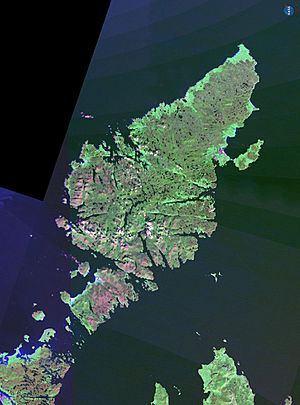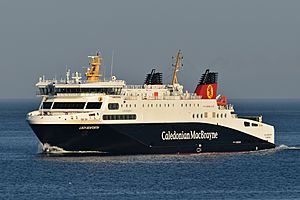Isle of Lewis facts for kids
Quick facts for kids Isle of Lewis
|
|
|---|---|
 |
|
| Area | 683 sq mi (1,770 km2) |
| Population | 18,500 |
| • Density | 27/sq mi (10/km2) |
| Demonym | Leòdhasach, Lewisian |
| Language | Scottish Gaelic English |
| OS grid reference | NB3030 |
| • Edinburgh | 276 miles (444 km) |
| Council area | |
| Lieutenancy area | |
| Country | Scotland |
| Sovereign state | United Kingdom |
| Post town | STORNOWAY ISLE OF LEWIS |
| Postcode district | HS1, HS2 |
| Dialling code | 01851 |
| Police | Northern |
| Fire | Highlands and Islands |
| Ambulance | Scottish |
| EU Parliament | Scotland |
| UK Parliament |
|
| Scottish Parliament |
|
The Isle of Lewis (Scottish Gaelic: Eilean Leòdhais), or just Lewis (Scottish Gaelic: Leòdhas), is the northern part of Lewis and Harris. This is the largest island in the Outer Hebrides of Scotland. Even though they are part of one island, Lewis and Harris are often talked about as if they were separate. Lewis covers about 683 square miles (1,769 square kilometers).
Lewis is mostly flat, while the other part, Harris, has more mountains. Because Lewis is larger and has flatter, more fertile land, most of the people in the Western Isles live here. The biggest town, Stornoway, is also on Lewis. The island has many different natural places, which are home to animals like the golden eagle, red deer, and seals. These areas are protected to keep nature safe.
Lewis has a strong Presbyterian history and a rich past. It was once part of the Norse Kingdom of the Isles. Today, life on Lewis is special. Things like observing the Sabbath, speaking Scottish Gaelic, and cutting peat for fuel are still very important. Lewis also has many interesting myths and legends, as well as local stories and music.
Contents
What's in a Name?
The Scottish Gaelic name Leòdhas might come from the old Norse word Ljoðahús, which means 'song house'. Some people think it comes from the Gaelic word leogach, meaning 'marshy'. It might be the place Ptolemy called Limnu, which also means 'marshy'. Another name for the island, used in poems or for cultural reasons, is Eilean an Fhraoich. This means 'Heather Isle' and refers to the whole island of Lewis and Harris.
A Look Back in Time
The first signs of people living on Lewis go back about 8,000 years. Early people burned parts of the forests to create land for deer to graze. The oldest archaeological findings are from about 5,000 years ago. At that time, people started living in permanent farms instead of moving with their animal herds. Small houses from these early settlers have been found across the Western Isles, for example, at Dail Mòr, Carloway. The most impressive ancient structures are the temples and burial mounds at places like Calanais (Callanish).
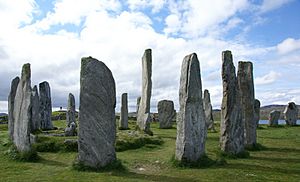
Around 500 BC, the island moved into the Iron Age. Buildings became larger, leading to the creation of brochs. These were round, dry-stone towers built by local leaders. They show that life back then could be uncertain. The best example of a broch on Lewis is at Dùn Chàrlabhaigh (Dun Carloway). The Scots arrived in the first centuries AD, bringing the Scottish Gaelic language. As Christianity spread, Lewis was home to the Picts.
In the 9th century AD, the Vikings began to settle on Lewis after years of raiding. These Norse invaders married local people and stopped following their old beliefs. Buildings started to be rectangular, like the Scandinavian style. Lewis became part of the Kingdom of Mann and the Isles, which was linked to Norway. The famous Lewis chessmen, found on the island in 1831, are from the time of Viking rule. The people were called Norse Gaels, showing their mixed background. Many island place names still come from the Norse language today.
Lewis became part of Scotland again in 1266, after the Treaty of Perth with Norway. Later, the Lord of the Isles became a powerful leader in western Scotland. Control of Lewis was first held by the Macleod clan. After many conflicts, the land was given to the Mackenzies in 1609.
After the 1745 rebellion, the use of Scottish Gaelic was discouraged. Many people left the island to go to the New World. In 1844, Sir James Matheson bought Lewis. However, hard times and changes in land use forced many more people to leave. Those who stayed faced difficulties as large areas of land were used for sheep or hunting.
During the First World War, many islanders served in the armed forces. A sad event happened when 208 naval reservists from the island died. They were returning home after the war when their ship, HMY Iolaire, sank near Stornoway harbour. Many people from Lewis also served in the Royal Navy and Merchant Navy during the Second World War. After the wars, many more people moved to the Americas and mainland Scotland.
In 1918, Lord Leverhulme bought the Isle of Lewis. He wanted to turn Stornoway into an industrial town and build a fish cannery. His plans were popular at first. But when he opposed people getting their land back, there were more land raids. These raids were successful, and Lord Leverhulme gave up his plans for Lewis. He then focused on Harris, where the town of Leverburgh is named after him.
Historic Places to Visit
The Isle of Lewis has many interesting historical and archaeological sites. These include:
- Callanish Stones
- Dun Carloway Broch
- Iron Age houses near Bostadh (Great Bernera)
- The Garenin blackhouse village in Carloway
- The Black House at Arnol
- Bragar whale bone arch
- St Columba's church in Aignish
- Teampull Mholuaidh in Ness
- Clach an Truiseil monolith
- Lews Castle
- Butt of Lewis cliffs and Butt of Lewis Lighthouse
- Dùn Èistean, a small island important to the Lewis Clan Morrisons
- Ui Church, a burial place for clan chiefs
There are also many smaller stone circles and the remains of five other brochs.
Island Geography
Much of Lewis has sandy beaches with dunes and machair (fertile grassy plains) on the west coast. Inland, there is a large, flat area covered in peat. The eastern coast is rockier, with cliffs and small coves. Most people live on the eastern side because the land is more fertile. Stornoway is the largest town and the only one on the island. Except for Achmore in the middle, all villages are on the coast.
Compared to Harris, Lewis is quite flat. The highest points are Mealaisbhal, which is 574 meters (1,883 feet) high, and Beinn Mhor, at 572 meters (1,877 feet). Southern Lewis has many freshwater lochs (lakes).
The coastline is very jagged, forming many large sea lochs like Lochs Resort and Seaforth. These lochs help form the border with Harris. Loch Roag surrounds the island of Great Bernera, which is connected to Lewis by a bridge. Important points on the coast include the Butt of Lewis in the far north, with its tall cliffs and lighthouse.
Island Rocks and Land
The rocks of Lewis are mostly very old metamorphic rocks called gneisses. There are also some areas of granite and basalt, and some sandstone near Stornoway.
Weather on Lewis
Lewis has a cool, moist climate because it is near the Atlantic Ocean and the Gulf Stream. Temperatures do not change much between summer and winter. Both seasons are often cloudy and have a lot of rain and strong winds, especially in autumn. These strong winds mean Lewis could be a good place for a large wind farm, which has caused some debate.
| Climate data for Lewis | |||||||||||||
|---|---|---|---|---|---|---|---|---|---|---|---|---|---|
| Month | Jan | Feb | Mar | Apr | May | Jun | Jul | Aug | Sep | Oct | Nov | Dec | Year |
| Mean daily maximum °C (°F) | 7.0 (44.6) |
7.4 (45.3) |
8.7 (47.7) |
11.0 (51.8) |
12.7 (54.9) |
15.0 (59.0) |
16.7 (62.1) |
16.2 (61.2) |
14.7 (58.5) |
12.2 (54.0) |
9.5 (49.1) |
7.5 (45.5) |
11.6 (52.8) |
| Mean daily minimum °C (°F) | 2.8 (37.0) |
3.0 (37.4) |
3.1 (37.6) |
4.6 (40.3) |
6.4 (43.5) |
9.1 (48.4) |
10.9 (51.6) |
10.8 (51.4) |
9.6 (49.3) |
7.4 (45.3) |
5.0 (41.0) |
2.8 (37.0) |
6.3 (43.3) |
| Average rainfall mm (inches) | 118.8 (4.68) |
136.4 (5.37) |
150.4 (5.92) |
84.8 (3.34) |
124.8 (4.91) |
98.0 (3.86) |
119.0 (4.69) |
150.6 (5.93) |
141.2 (5.56) |
187.0 (7.36) |
165.0 (6.50) |
224.4 (8.83) |
1,700.4 (66.95) |
| Mean monthly sunshine hours | 34.5 | 63.4 | 104.9 | 147.1 | 192.2 | 166.4 | 127.9 | 132.6 | 106.6 | 77.2 | 44.3 | 26.2 | 1,223.3 |
| Source 1: Met Office (Data January 1874 – November 2006)
Temperature figures are average figures for that month; other figures are averages of monthly totals. |
|||||||||||||
| Source 2: Hebrides Weather | |||||||||||||
Nature and Wildlife
Lewis has 15 Sites of Special Scientific Interest for biology. The Lewis Peatlands are very important wetland areas for birds that live there all year or migrate.
Birds of Lewis
Many kinds of seabirds live along the coast of Lewis. These include shags, gannets, fulmars, kittiwakes, guillemots, and different types of gulls. Inside the island, you can find red grouse and woodcock.
In the Uig hills, you might see both golden and white-tailed eagles. In the Pairc area, look for oystercatchers and curlews. A few pairs of peregrine falcons live on the coastal cliffs. Merlins and buzzards are common everywhere on the hills. In winter, many different kinds of wildfowl visit. Several species of waterfowl, like eider and long-tailed duck, are found in the shallow waters around Lewis.
Marine Animals
Salmon swim up several Lewis rivers after crossing the Atlantic Ocean. Many freshwater lochs are home to fish like trout. Other freshwater fish include Arctic char, European eel, and different types of sticklebacks.
Out in the sea, it is common to see grey seals, especially in Stornoway harbour. If you are lucky, you might spot dolphins, harbour porpoises, sharks, and even whales.
Land Mammals
Lewis has two native land mammals: red deer and otter. Other animals like rabbits, mountain hares, hedgehogs, and rats were brought to the island by people. The origin of mice and voles is not certain.
American mink, which escaped from fur farms, cause problems for native ground-nesting birds and local fishing. Efforts are being made to remove mink from Lewis and Harris.
Some people claim that bats live in the Stornoway castle grounds. Also, some residents keep farm animals like Hebridean sheep, Highland cattle, and a few pigs.
Reptiles and Amphibians
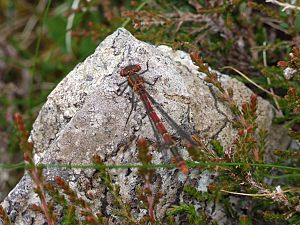
Like Ireland, Lewis has no snakes. The only reptile is the slowworm, which is a legless lizard. The common frog can be found in the middle of the island. Frogs, newts, and toads were also brought to the island by people.
Insects
The island's most famous insect is the Scottish midge. These tiny biting insects are often found near water at certain times of the year.
In the summer, you can find several types of butterflies and dragonflies, especially around Stornoway. The rich insect life on Lewis means that many carnivorous plants, like sundews, grow well here.
Island Plants and Flowers
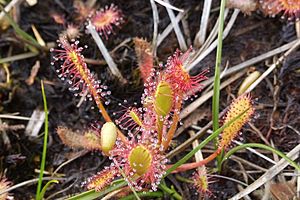
The machair is known for its different kinds of orchids and other plants. Three types of heather – ling, bell heather, and cross-leaved heath – cover large areas of moorland. These moorlands also have many insectivorous plants like sundews. The wide areas of heather explain why the island is called Eilean an Fhraoich, which means "The Heather Isle" in Scottish Gaelic.
Lewis was once covered in forests. Now, only small natural woods remain on inland cliffs and islands within lochs, safe from fires and sheep. In recent years, new plantations of spruce and pine trees were planted. The most important mixed woods are those around Lews Castle in Stornoway, planted in the mid-1800s.
People of Lewis
Lewis's main town is Stornoway (Scottish Gaelic: Steòrnabhagh). From here, ferries sail to Ullapool on the Scottish mainland. In 2011, Lewis had a population of 19,658 people.
Most of the island's villages are on or near the coasts or sea lochs, especially on the northeast coast. The middle of the island is a large area of moorland. People traditionally cut peat here for fuel, though this is less common now. The southern part of the island, next to Harris, has more mountains and inland lochs.
Areas and Villages of Lewis
Lewis is divided into different areas. These include:
- Ness
- Carloway
- Back
- Lochs (Na Lochan)
- Park (A' Phàirc)
- Point (An Rubha)
- Stornoway
- West Side
- Bernera
- Uig
The West Side is a general name for villages from Borve to Dalbeg.
While Stornoway has about 8,000 people, several large villages are also important. These include North Tolsta, Carloway, and Leurbost. Villages near Stornoway like Laxdale, Sandwick, and Holm have become like suburbs of the town. The total population of the greater Stornoway area is closer to 12,000.
The island of Great Bernera has the first planned crofting township, Kirkibost, created in 1805.
Here is a list of some villages in Lewis by area:
- Ness
-
- Melbost, South Galson, North Galson, South Dell, North Dell, Cross, Swainbost, Habost, Lionel, Port of Ness, Eoropie, Fivepenny, Knockaird, Adabrock, Eorodale, Skigersta, Cross-Skigersta Road
- North Lochs
- Park (South Lochs)
- Point
-
- Aird, Aignish, Flesherin, Lower Bayble, Portnaguran, Portvoller, Sheshader, Shulishader, Upper Bayble, Eagleton
- Uig
-
- Aird Uig, Cliff, Kneep, Timsgarry, Valtos, Breanish, Islivik, Meavag, Mangursta, Crowlista, Geishader, Carishader, Gisla, Carloway, Garynahine, Callanish, Breasclete, Breaclete, Kirkibost, Tobson, Hacklete
Island Economy
Traditional jobs on Lewis include crofting (small-scale farming), fishing, and weaving. These industries were very important in the past but are now smaller. Crofting today is mostly for people to grow their own food. More than 40% of working people are employed by the local government or health services. Tourism is the only growing business.
Tourism is the main industry in the Outer Hebrides. It brings in about £65 million and supports around 1,000 jobs. The islands get about 219,000 visitors each year. Lewis receives about 45% of these visitors.
The Harris tweed industry is now mostly in Lewis. The main finishing mills are in Shawbost and Stornoway. Every piece of Harris Tweed cloth has a special stamp. This stamp shows it was hand-woven by islanders in their homes in the Outer Hebrides. It must be made from pure new wool dyed and spun in the Outer Hebrides.
Besides the businesses in Stornoway, many historical sites have visitor centers, shops, or cafes. There is also a factory near Breasclete that studies fatty acids for medicine.
The main fishing fleet in Stornoway is smaller than it used to be. However, many smaller boats still fish close to shore. They use creels (traps) and operate from local harbours around Lewis. There are also fish farms in many sea lochs. The fishing industry, including processing and transport, employs many people.
Shopping and Services
Stornoway is the main shopping area on Lewis. It has several big chain stores and supermarkets, as well as many local businesses. Outside Stornoway, many villages have a general store, often with a post office. Some villages have special shops like pharmacies or petrol stations. There are almost no public pubs in rural areas. Instead, local hotels or inns offer places to eat, drink, and stay. A new whisky distillery, Abhainn Dearg distillery, has recently opened in Uig.
Mobile shops also travel around the island to visit remote places. However, it is now easier to travel to Stornoway or shop online. This has caused many village shops to close. The Royal Bank of Scotland also provides mobile banking services to remote villages.
Getting Around Lewis
A daily Caledonian MacBrayne ferry (MV Loch Seaforth) sails from Stornoway to Ullapool on the Scottish mainland. The trip takes 2 hours and 30 minutes. There are two return trips a day, and one on Sundays in winter. Other ferries from Harris can take you to Skye and Uist.
In 2007, there were ideas about building an undersea tunnel to connect Lewis to the Scottish mainland. One idea was a tunnel over 50 miles (80 km) long between Stornoway and Ullapool. This would be the longest road tunnel in the world.
Stornoway is the main place for public transport on Lewis. Bus services go to Point, Ness, Back and Tolsta, Uig, the West Side, Lochs, and Tarbert, Harris. These services are run by the local council and private companies.
Stornoway Airport is 2 miles (3 km) from the town. Loganair flies from Stornoway to Edinburgh, Inverness, and Glasgow. Hebridean Air Services flies to Benbecula. The airport is also home to a HM Coastguard Search & Rescue helicopter.
Peat for Fuel
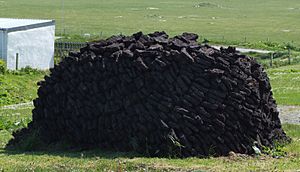
People in many parts of Lewis still cut peat to use as fuel. Peat is usually cut in late spring using a special tool called a tairsgeir. This tool has a long wooden handle and an angled blade. First, the heather is cleared from the peat bank. Then, the peat is cut and thrown out to dry. A skilled person can cut 1,000 peats in a day.
Once dry, the peats are taken to the croft (farm) and stacked. These stacks often look like the croft house itself. They are wide, curved at each end, and taper to a point about 2 meters (6.5 feet) high. A croft might burn 15,000 to 18,000 peats in a year.
The smell of peat smoke, especially in winter, adds to the island's atmosphere. While peat burning is still done, it has become less common as people use other heating methods. However, it remains an important part of island life. In 2008, when other fuel prices went up, some people started cutting peat again.
Religion on Lewis
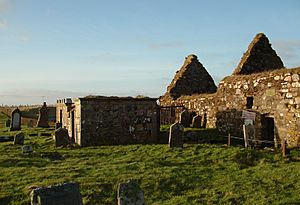
Religion is very important on Lewis. Most people belong to the Free Church or the Church of Scotland. Both are Presbyterian churches. The Sabbath (Sunday) is generally observed. Most shops and places that sell alcohol are closed on this day. However, there have been scheduled flights and ferry services to mainland Scotland on Sundays since 2009.
While Presbyterianism is dominant, other churches are also present. There is a Catholic church, a Scottish Episcopal Church (part of the Anglican Communion), a Salvation Army corps, a Pentecostal church, a Plymouth Brethren church, a Baptist church, a meetinghouse of the LDS Church, and a Jehovah's Witness Kingdom Hall in Stornoway. The island's first mosque opened in Stornoway in May 2018.
Some churches on Lewis practice precenting the line. This is a unique style of singing psalms in Scottish Gaelic where one person sings a line, and then the congregation sings it back.
Learning and Education
School education on Lewis is managed by Comhairle nan Eilean Siar, the local council. There are 15 schools for children aged 5 to 18. A special feature is that many primary schools (12 out of 14) offer Scottish Gaelic medium education. The Nicolson Institute is the only secondary school on the island. Because there are many village schools, class sizes were often small. As student numbers dropped, some rural secondary departments and primary schools closed.
Stornoway is home to a small campus of the University of Stirling. It teaches nursing and is based at Ospadal nan Eilean (Western Isles Hospital). There is also a college for further education, Lews Castle College. This college offers vocational and community education in rural learning centers and on its main campus. Subjects include basic computer skills, Scottish Gaelic language classes, and maritime qualifications.
Culture and Fun
Language and Heritage
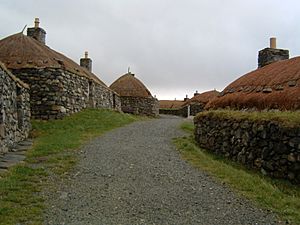
Lewis has a language history rooted in both Scottish Gaelic and Old Norse. Both still influence life on Lewis. Today, both Scottish Gaelic and English are spoken. In daily life, a mix of English and Scottish Gaelic is very common. Because of the Scottish Gaelic influence, the English accent on Lewis often sounds more like Irish or Welsh accents. Scottish Gaelic culture is stronger in the Western Isles than anywhere else in Scotland. About 60% of islanders speak Scottish Gaelic daily, and 70% have some knowledge of it. Most road signs are in both English and Scottish Gaelic. Almost all Gaelic speakers are bilingual.
Most place names in Lewis and Harris come from Old Norse. The name "Lewis" is the English spelling of the Scottish Gaelic Leòdhas. This comes from the Old Norse Ljóðhús, which is how Lewis was named on old Norwegian maps.
Media and Arts
Lewis often hosts the Royal National Mòd, a big festival of Gaelic culture. There are also local mòds each year. Stornoway Castle Green hosts the annual 3-day Hebridean Celtic Festival in July. This festival attracts over 10,000 visitors. It includes events like cèilidhs (traditional social gatherings), dances, and concerts with storytelling, songs, and music from island performers and beyond.
The radio station Isles FM is in Stornoway. It broadcasts on 103FM with a mix of Scottish Gaelic and English programs. Stornoway also has a studio for BBC Radio nan Gàidheal and Studio Alba, an independent TV studio.
The Stornoway Gazette is the main local newspaper, published weekly. The Hebridean is a sister paper. Some local groups in rural areas have their own publications.
Lewis has been home to, or inspired, many writers. These include author Kevin MacNeil, whose novel The Stornoway Way is set in the island's capital. Parts of the crime series by GR Jordan are also set here.
Sports and Activities
Lewis has good sports grounds and centers. Sports like football, rugby union, and golf are popular.
- Football became popular after the First World War. It is the most popular amateur sport on Lewis. Goathill Park in Stornoway hosts special matches. Local teams play in the Lewis and Harris Football League.
- Shinty was traditionally played on the island but stopped by the mid-20th century. It was brought back in the 1990s. Now, there is a strong local club called Lewis Camanachd that competes nationally.
- The village of Tong, near Stornoway, hosts the Highland Games and the Western Isles Strongest man competition every summer.
- The Ionad Spors Leòdhais (Lewis Sports Centre) is next to the Nicolson Institute School. It has an all-weather pitch and running track.
- The Lews Castle Grounds is home to Stornoway Golf Club. It is the only 18-hole golf course in the Outer Hebrides.
- Angling (fishing) is a very popular hobby on Lewis. There are many good lochs and rivers for fishing.
- Since Lewis is an island, water sports like surfing are popular.
- Lewis has great terrain for hillwalking, especially in Uig and near the border with Harris.
Myths and Legends
The Isle of Lewis has many rich folk tales. These include Seonaidh, a water-spirit who was offered ale in the area of Teampull Mholuaidh in Ness. There are also The Blue Men who lived in the Minch, the stretch of water between Lewis and the Shiants.
Local Food
Each year, men from Ness go to the island of Sula Sgeir in late August. For two weeks, they harvest young gannets called Guga. These are a special local food.
Famous People from Lewis
- Aonghas Caimbeul, a Scottish Gaelic war poet and author.
- Alistair Darling, a former government minister, had family links to Great Bernera.
- Kenny Boyle, an award-winning actor, author, and playwright from Cromore.
- Angus MacAskill, known as the tallest non-pathological giant in history.
- Cathy MacDonald, a BBC Alba television presenter.
- John MacKay, a news anchorman for STV.
- Alexander MacKenzie, a famous explorer.
- Mary Anne MacLeod, the mother of former U.S. President Donald Trump.
- Kevin MacNeil, a well-known novelist, poet, and playwright.
- Donald Stewart, a politician and former President of the Scottish National Party.
- Derick Thomson, a Scottish Gaelic poet.
- Alasdair White, a musician who plays with the Battlefield Band.
See also
 In Spanish: Isla de Lewis para niños
In Spanish: Isla de Lewis para niños



